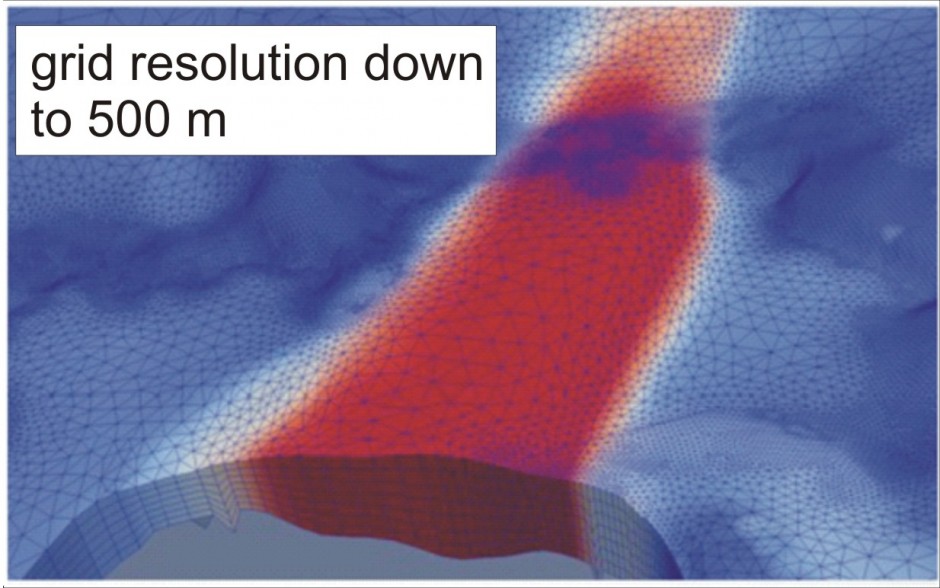Dr Adam Booth, now becoming a regular contributor to GeoLog, is about to begin a post-doctoral position at Imperial College, London. This is his final report from the 2012 General Assembly, following articles on subglacial lakes and mountain glacier research more generally.
Another year, another conference! This is my final post from the EGU’s General Assembly and, again, I’ve found it a really useful meeting – both in terms of the presentations I’ve seen and the people I’ve spoken to. I’m wrapping up my blogs with a conversation with Dr Gaël Durand, of the Laboratoire de Glaciologie et Géophysique de l’Enivronment (LGGE) at the Université de Grenoble, France. Gaël is this year’s recipient of the ‘Outstanding Young Scientist Award’ for EGU’s Crysophere Division, so I collared him during Thursday night’s poster presentations for the lowdown on his research – and what it is that makes it so medal-worthy! “It’s not me you should ask!” he laughs, but it soon becomes clear why Gaël’s experiences make him an ideal candidate for recognition.
If you attend a series of glaciological presentations, you’ll find scientists who are interested in all size scales of the cryosphere: from the micro-structure of snow and ice crystals to the growth and decline of continental-sized ice masses – it really isn’t size that counts. Gaël’s current research is of the ‘large-scale’ variety. Using powerful computer algorithms, Gaël and his colleagues are able to model and predict the flow dynamics of ice-sheets (such as those that cover Greenland and Antarctica). In my limited experience of computer modelling, I’ve always understood that flow models do a good job of characterising bulk ice properties – but their quality becomes poor when you ‘zoom in’ to individual glaciers, since their small-scale dynamics are just too complex. However, in talking to Gaël, I discover that this opinion is becoming a thing of the past, and that the rate of advance in ice-sheet modelling is anything but glacial. “Our models are now much more complex than before,” he says, “and we can deal with each glacier individually.” The figure below shows an example of this complexity in a model of Pine Island Glacier, Antarctica. The fine-detail of glacier dynamics is represented using an adaptive mesh (the network of triangles in the image), which offers model resolution as small as 500 m; only a few years ago, the best resolution that could be used was no smaller than a few tens of kilometres.
A cutting-edge model of glacier flow velocity for Pine Island Glacier, Antarctica (red and blue colours show faster and slower velocities, respectively). The model complexity allows grid resolution to shrink as low as 500 m. Note how the mesh is much finer across velocity transitions.
Perhaps Gaël’s desire to improve model complexity stems from his early experiences in glaciology? As a PhD student at the Université de Grenoble he worked on a finer-scale altogether. Using an ice core from the EPICA Dome C project, Gaël spent hours in a cold lab, slicing the core into thin-sections for microscopic analysis. He tells me that “the 3 kilometre ice core was sliced every 10 m,” resulting in hundreds of thin-sections – and hundreds of days spent in a freezing cold room! But the hard (and cold!) work paid off, as the microscopic structure of the ice crystals (measured with an ‘Automatic Ice Texture Analyser’ at the University of Copenhagen) revealed detailed information about the deformation history of individual ice layers. Gaël then collaborated with ice-flow modelers to explain the observed deformation fabrics, and thereby established his own niche: a computer modeler with direct experience of the importance of the smallest-scale ice properties.
Eager to discover what else I didn’t know about ice-sheet modelling, I asked Gaël where the most significant developments were happening right now. His immediate answer is “ice-sheet grounding lines.” Although an ice-sheet is predominantly land-based, Antarctica in particular is fringed by floating ice, where the ice sheet overrides the open ocean. The grounding line is therefore the position where the ice-sheet starts to float.
Sketch of an ice-sheet’s grounding line. The grounding line represents the transition from ice resting on land to ice floating on the ocean.
“The problem is that basal conditions are drastically changing,” Gaël says. “The ice-sheet quickly goes from resting on a hard bed to floating on the ocean. We had big problem defining where the ice is floating, and where it is not.” In the last year, however, ‘Full Stokes’ modelling methods have revolutionised the representation of grounding line processes; furthermore, as shown earlier, typical model resolution has been sharpened ten-fold. Such advances have benefited from developments in supercomputer technology, although the vital statistics of their performance are still eye-watering: with 100 computer processors at his disposal, Gaël’s simulations of a century’s worth of ice-flow still take around a week to output results!
I dared to ask when we’d be able to model the whole of the Antarctic ice-sheet, including the unique properties of all its individual glaciers. Genuinely expecting to be told to forget about it, I was amazed when Gaël answered “It will come soon.” In the next ten years? Within the next one year! Gaël is confident that some sophisticated models on the cusp of development will have the required complexity to do the job.
A conversation with Gaël really encapsulates much of what we’re trying to do as glaciologists. Our end goal is to predict what will happen to the cryosphere under future climate scenarios – but, for this to happen, we require reliable and comprehensive observations of glacier systems such that they can be incorporated in a model (which strikes a strong chord with me as a field geophysicist). What made Gaël’s research medal-worthy? For me, his outlook really brings together all aspects of crysopheric science, and applies it at the cutting edge… but I might hold him to his one-year prediction at the next EGU!
By Adam Booth, post-doc at Imperial College, London



